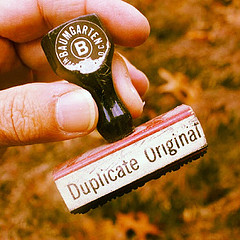Content strategy mistake: replicating old formatting with new tools
When remodeling your kitchen, would you replace 1980s almond melamine cabinets with the same thing? Probably not. (I certainly wouldn’t!) Then why make the content strategy mistake of using new tools to re-create the old formatting in your content?
If your company is spending the time and money on new tools for an updated content strategy, you’ve been given a rare gift: the opportunity to make changes. Those changes should include fixing bad, outdated formatting that makes content hard to read—and that reflects badly on the company as a whole.

Resist the temptation to duplicate old, legacy formatting when implementing tools for a new content strategy (flickr: woodleywonderworks)
Case in point: PDF output, which was a default output back in the day years ago.
If you’re working in a regulated industry requiring PDF output that adheres to a spec, making changes to (or discontinuing) PDF files isn’t an option. Meeting the PDF spec is a business requirement, even if the formatting dictated by those specs is ugly. Case closed.
For those not in a regulated industry, the considerations are very different:
- Should PDF even be your primary output focus? If your customers are accessing content on mobile devices, PDF is not the best choice for them anyway. You need a mobile friendly output (adaptive HTML? app?) for those customers, but you also can’t unilaterally end PDF production if customers are accustomed to PDF. A good compromise: still provide PDF files—possibly with a simplified layout—as links from HTML versions of content, which you position as the primary way to access the content.
- Does your page design need rejuvenating? If you’ve been churning out PDF files with the same design the past 5–10 years, there is a zero-percent probability the formatting reflects current design principles. If necessary, get a design consultant’s input, particularly on this question: Does the formatting help or hinder readers? It’s also worth noting some people—particularly those of us in any publishing-related industry—do pay attention to formatting. How many times have you seen outdated formatting in PDF files (or any other output, really) and assumed the company providing the information was behind the times, too? Confess!
- Did workarounds for shortcomings of previous tools lead to compromises in formatting? If your old tool set had quirks in regard to page layout, PDF production, and so on, you may have instituted workarounds resulting in suboptimal formatting. No need to perpetuate those compromises in your updated output.
The surface appeal of cloning what you already have is understandable. Existing look-and-feel provides a definitive target, and content creators are probably comfortable with said target. However, unless there is a compelling business reason to reconstitute old formatting with your new tools—and “We’ve done it this way forever” generally is not—don’t do it.
If you need more proof cloning can be bad, just watch TV:



Larry Kunz
This is kind of the opposite of the “Granite countertops effect, but you’re right: it’s very common.
Usually when I see this, it’s because the client simply can’t imagine anything beyond what they’re currently doing. Maybe they’re convinced from a management point-of-view that structured authoring (or whatever) is the way to go. And they’re not averse to changing the design. But they just can’t envision any design
beyond the current one. The consultant must come in with both recommendations and examples — just as the kitchen-supply store has a showroom so that customers can see the possibilities for themselves.
Alan Pringle
Taking a look at a competitor’s public-facing content AND that from other industries is often helpful in developing updated formatting specs.
That said, on more than one project, I have seen some individuals push for maintaining the status quo in formatting for reasons I suspected were less than noble. When personal desires and preferences drive decisions instead of business goals, the result is rarely good.
Erin Vang
And you really shouldn’t replicate the formatting from three tools ago that was old-looking even back in the 1980s when someone had just discovered
<insert dreadful tool name here>. Not that I know of any cases where that has happened. No, sir, not me.Alan Pringle
I fixed your angle brackets.
And I know nothing.